The Bolt Anchorage Performance of Fractured Rock under a Freeze–Thaw Cycle Load
Abstract
:1. Introduction
2. Experimental Introduction
2.1. Specimens
2.2. Experimental Design
3. Numerical Simulation Parameters
4. Analysis and Discussion
4.1. The Influence of Fracture Dip Angle on Anchor Specimen Strength
4.2. Impact of Anchoring Conditions on Specimen Strength
4.3. Effect of Freeze–Thaw Cycles on the Strength of Specimens
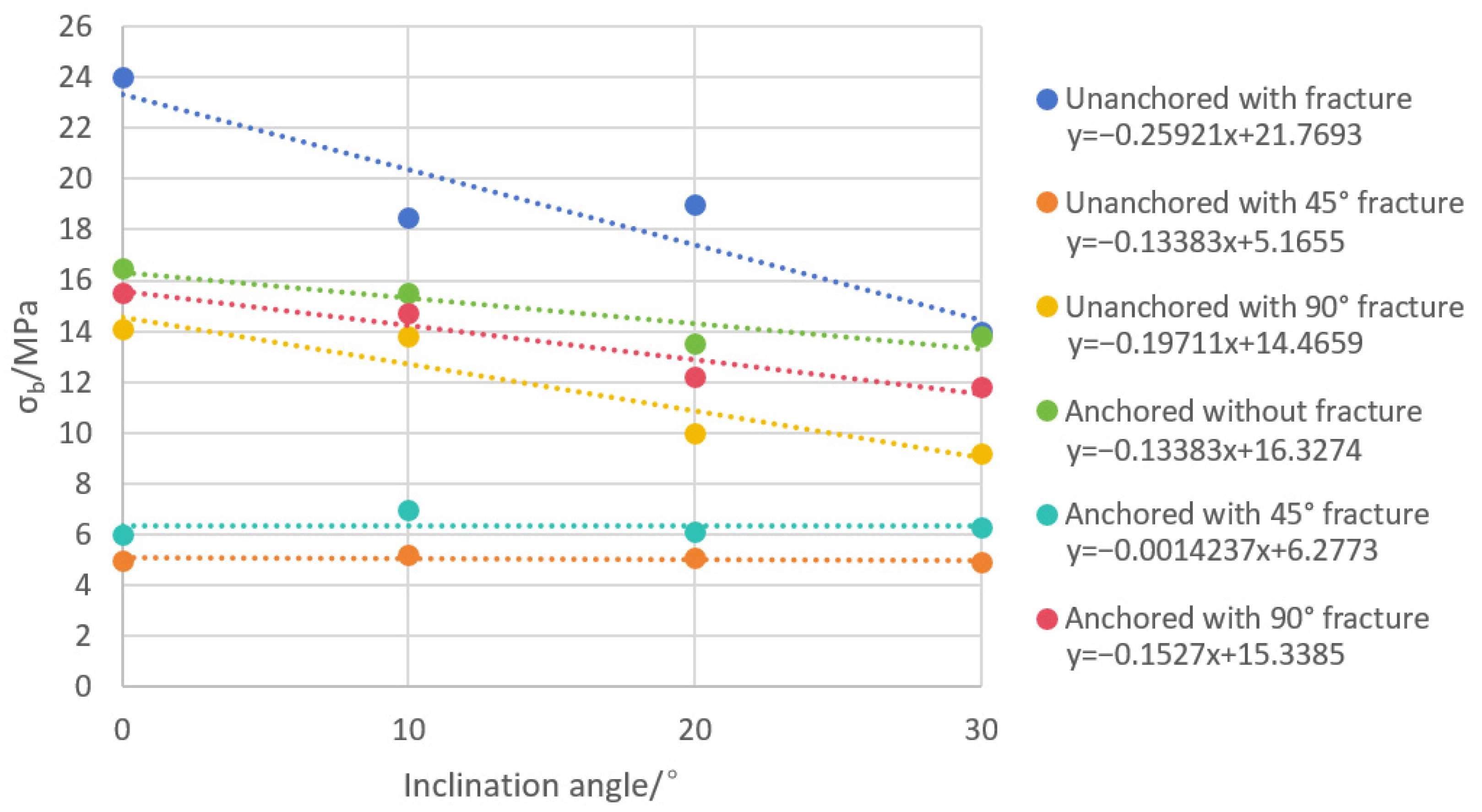
4.4. Stress–Strain Relationship
4.5. Analysis of Failure Modes and Crack Development
4.5.1. Laboratory Test Results
- (1)
- As shown in Figure 11(a-1), the specimen without bolts or prefabricated fractures exhibits a failure mode characterized by local spalling and overall brittle irregular shear. Fractures initiate from the surface in the form of local tensile-induced vertical wing fractures. As these fractures propagate vertically, adjacent fracture edges intersect to form oblique fractures and even lateral fractures with bulging, some of which progress inward, leading to partial spalling. As illustrated in Figure 11(a-2), the oblique fractures and vertical fractures that have not yet resulted in spalling continue to propagate inward, with larger fractures penetrating the specimen upon failure.
- (2)
- The specimen with bolts but without prefabricated fractures displays a failure mode characterized by local spalling and brittle shear failure developing around the bolt-induced stress concentration zone. As shown in Figure 11(b-1), fractures initiate from the end face and around the bolt-induced stress concentration zone, manifesting as local tensile-induced vertical or oblique wing fractures. Some surface fractures intersect and propagate inward, potentially resulting in spalling. As depicted in Figure 11(b-2), the failure surface typically consists of fractures that independently or mutually communicate through vertical–oblique cracks, oblique–oblique cracks, or Y-shaped cracks formed by the bolt.
- (3)
- In Figure 11(c-1), the specimen with a 45° prefabricated fracture but without bolts exhibits a failure mode characterized by brittle sliding along the prefabricated structural surface. Prior to failure, the specimen also exhibits local tensile-induced vertical wing fractures, some of which have the opportunity to form spalling zones or similar spalling-like morphologies before complete failure. As shown in Figure 11(c-2), near failure, certain parts of the specimen’s surface projected along the long axis of the prefabricated fracture initiate shear fractures, which subsequently extend to form an entire oblique fracture surface, resulting in complete internal sliding along the prefabricated structural surface upon failure.
- (4)
- The specimen with a 45° prefabricated fracture and bolts exhibits a failure mode characterized by brittle sliding along the prefabricated structural surface. This mode includes the development of vertical fractures along the end face, vertical fractures leading to spalling, and oblique fractures induced by the stress concentration zones around the bolt (as shown in Figure 11(d-1,d-2)). Additionally, there are fractures expanding outward from the prefabricated structural surface, with some fractures overlapping and interconnecting. During the specimen’s sliding along the prefabricated structural surface, the bolt anchorage restricts movement. As failure occurs, fractures propagate outward around the bolt, and once the fractures reach a critical size and quantity, the anchorage effect fails, leading to specimen failure.
- (5)
- The specimen with a 90° prefabricated fracture but without bolts exhibits a failure mode characterized by local spalling and overall brittle multi-angle shear. During the fracture development stage, local tensile-induced vertical wing fractures are observed. As these fractures propagate vertically, adjacent fracture edges intersect to form oblique fractures (as shown in Figure 11(e-1)), with some specimens also exhibiting lateral fractures and bulging. The failure mode includes one type of destruction along the prefabricated structural surface and its extensions, and another type of oblique brittle shear failure not along the prefabricated structural surface, as illustrated in Figure 11(e-2).
- (6)
- The specimen with a 90° prefabricated fracture and bolts exhibits a failure mode characterized by local spalling primarily induced by the stress concentration around the bolt and secondarily by developments along the prefabricated structural surface. Fractures initiate from the end face and around the bolt-induced stress concentration zone, manifesting as local tensile-induced vertical or oblique wing fractures. Some surface fractures intersect and propagate inward, potentially leading to spalling (as shown in Figure 11(f-1)). The failure surface typically comprises fractures that independently or mutually communicate through vertical–oblique cracks, oblique–oblique cracks, or Y-shaped cracks formed by the bolt. Fractures developing from the prefabricated structural surface may directly evolve into a penetrating fracture surface or may connect with the main penetrating fracture, resulting in an inclined penetrating failure surface, as depicted in Figure 11(f-2).
4.5.2. Numerical Simulation Results
- (1)
- In Figure 12a,b, for specimens without anchor rods and no pre-existing cracks, during uniaxial compression, oblique surface cracks and vertical surface cracks are observed, accompanied by spalling regions and occasional bulging spalling in the central area. Internal cracks are predominantly distributed across the inclined section of the breakthrough.
- (2)
- In Figure 12e,f, for specimens with a 45° pre-existing crack, surface cracks during uniaxial compression primarily occur on the inclined section, consistent with the pre-existing structural plane, with internal microcracks extending from the pre-existing structural plane.
- (3)
- Similarly, in Figure 12i,j, for specimens with a 90° pre-existing crack, surface oblique cracks and vertical cracks are observed during uniaxial compression, along with spalling regions, with a plethora of internal microcracks distributed around the pre-existing crack.
- (4)
- In Figure 12c,d, for specimens with anchor rods but no pre-existing cracks, during uniaxial compression, wing cracks extending from the stress concentration zones around the anchor rods are first observed, propagating outward as oblique cracks and vertical cracks. Additionally, localized spalling areas are present, with fracture surfaces intersecting with the stress concentration zones around the anchor rods.
- (5)
- Similarly, in Figure 12g,h, for specimens with anchor rods and a 45° pre-existing crack, the surface cracks during uniaxial compression primarily occur on the inclined section, consistent with the pre-existing structural plane, with internal microcracks extending from both the pre-existing structural plane and stress concentration zones around the anchor rods.
- (6)
- In Figure 12k,l, for specimens with anchor rods and a 90° pre-existing crack, during uniaxial compression, wing cracks extending from the stress concentration zones around the anchor rods are observed, propagating outward as oblique cracks and vertical cracks, with localized spalling areas. Internal microcracks originate from both the pre-existing structural plane and stress concentration zones around the anchor rods.
5. Conclusions
- (1)
- The angle of pre-existing fractures significantly influences the strength of rocks, with their strength ranking consistently as follows: specimens with 45° fractures < specimens with 90° fractures < intact specimens. Stress concentration occurs around the bolt, which weakens the compressive performance of intact specimens but enhances the strength of specimens containing fractures. Additionally, the bolt induces plasticity at the specimen’s peak, followed by post-peak ductility.
- (2)
- Freeze–thaw cycles notably degrade the compressive strength of specimens without cracks and with 90° pre-existing cracks, with a more pronounced weakening effect observed in specimens without anchor rods. The fitting line slopes of specimens without cracks and without anchor rods, specimens without cracks and with anchor rods, specimens with 90° pre-existing cracks and without anchor rods, and specimens with 90° pre-existing cracks and with anchor rods are −0.259, −0.134, −0.197, and −0.153, respectively. However, the effect of freeze–thaw cycles on specimens with 45° pre-existing cracks is less significant, indicating a weaker weakening effect on the strength of low-water-content pre-existing weak structural plane rocks.
- (3)
- The failure modes of specimens are influenced by the interaction between their pre-existing cracks and anchor rods. Both specimens with 45° pre-existing cracks and anchor rods and specimens without cracks and anchor rods exhibit sliding failure along the pre-existing crack plane, while specimens without cracks and with 90° pre-existing cracks, under no-anchor conditions, exhibit external spalling and internal large-angle shear failure. In terms of crack development, various types of specimens exhibit vertical or oblique wing cracks along the specimen surface, with specimens with 45° pre-existing cracks also exhibiting shear cracks generated by the extension of pre-existing cracks.
- (4)
- A coupled model combining the PFC3D discrete element method and FLAC3D finite difference method was employed to simulate the unfrozen experimental conditions. The specimen material was modelled using a parallel bonded constitutive model, the pre-existing structural plane was modelled using a smooth joint constitutive model, and the anchor rods were modelled using a linear elastic constitutive model. The simulation results are in good agreement with the experimental data.
- (5)
- Comparing the results of numerical simulations, specimens without bolts exhibit more pronounced localized spalling, whereas specimens with bolts show stress concentrations around the bolt, resulting in the formation of long and penetrating cracks. Internal microcracks within the specimens generally initiate from the bolt and pre-existing structural surfaces, with tension cracks being more prevalent than shear cracks.
Author Contributions
Funding
Institutional Review Board Statement
Informed Consent Statement
Data Availability Statement
Acknowledgments
Conflicts of Interest
References
- Elumalai, V.; Nwabisa, D.P.; Rajmohan, N. Evaluation of high fluoride contaminated fractured rock aquifer in South Africa—Geochemical and chemometric approaches. Chemosphere 2019, 235, 1–11. [Google Scholar] [CrossRef] [PubMed]
- Guo, B.; Zang, W.; Yang, F.; Han, B.; Chen, S.; Liu, Y.; Yang, X.; He, T.; Chen, X.; Liu, C.; et al. Spatial and temporal change patterns of net primary productivity and its response to climate change in the Qinghai-Tibet Plateau of China from 2000 to 2015. J. Arid. Land 2020, 12, 1–17. [Google Scholar] [CrossRef]
- Abdolghanizadeh, K.; Hosseini, M.; Saghafiyazdi, M. Effect of freezing temperature and number of freeze–thaw cycles on mode I and mode II fracture toughness of sandstone. Theor. Appl. Fract. Mech. 2020, 105, 102428. [Google Scholar] [CrossRef]
- Liu, Y.; Dai, F. A review of experimental and theoretical research on the deformation and failure behavior of rocks subjected to cyclic loading. J. Rock Mech. Geotech. Eng. 2021, 13, 1203–1230. [Google Scholar] [CrossRef]
- Lindner, F.; Wassermann, J.; Igel, H. Seasonal freeze-thaw cycles and permafrost degradation on Mt. Zugspitze (German/Austrian Alps) revealed by single-station seismic monitoring. Geophys. Res. Lett. 2021, 48, e2021GL094659. [Google Scholar] [CrossRef]
- Yang, M.; Wang, S.; Yao, T.; Gou, X.; Lu, A.; Guo, X. Desertification and its relationship with permafrost degradation in Qinghai-Xizang (Tibet) plateau. Cold Reg. Sci. Technol. 2004, 39, 47–53. [Google Scholar] [CrossRef]
- Cao, R.-H.; Cao, P.; Lin, H.; Ma, G.; Chen, Y. Failure characteristics of intermittent fissures under a compressive-shear test: Experimental and numerical analyses. Theor. Appl. Fract. Mech. 2018, 96, 740–757. [Google Scholar] [CrossRef]
- Morgan, S.P.; Johnson, C.A.; Einstein, H.H. Cracking processes in Barre granite: Fracture process zones and crack coalescence. Int. J. Fract. 2013, 180, 177–204. [Google Scholar] [CrossRef]
- Sarfarazi, V.; Ghazvinian, A.; Schubert, W.; Blumel, M.; Nejati, H.R. Numerical Simulation of the Process of Fracture of Echelon Rock Joints. Rock Mech. Rock Eng. 2013, 47, 1355–1371. [Google Scholar] [CrossRef]
- Mohammadi, H.; Pietruszczak, S. Description of damage process in fractured rocks. Int. J. Rock Mech. Min. Sci. 2019, 113, 295–302. [Google Scholar] [CrossRef]
- Wu, G.S.; Yu, W.J.; Zuo, J.P.; Du, S.H. Experimental and theoretical investigation on mechanisms performance of the rock-coal-bolt (RCB) composite system. Int. J. Min. Sci. Technol. 2020, 30, 759–768. [Google Scholar] [CrossRef]
- Li, T.; Pei, X.; Wang, D.; Huang, R.; Tang, H. Nonlinear behavior and damage model for fractured rock under cyclic loading based on energy dissipation principle. Eng. Fract. Mech. 2019, 206, 330–341. [Google Scholar] [CrossRef]
- Yahaghi, J.; Liu, H.; Chan, A.; Fukuda, D. Experimental and numerical studies on failure behaviours of sandstones subject to freeze-thaw cycles. Transp. Geotech. 2021, 31, 100655. [Google Scholar] [CrossRef]
- Niu, Y.; Zhou, X.; Zhang, J.; Qian, Q. Experimental study on crack coalescence behavior of double unparallel fissure-contained sandstone specimens subjected to freeze-thaw cycles under uniaxial compression. Cold Reg. Sci. Technol. 2019, 158, 166–181. [Google Scholar] [CrossRef]
- Liu, Y.; Cai, Y.; Huang, S.; Guo, Y.; Liu, G. Effect of water saturation on uniaxial compressive strength and damage degree of clay-bearing sandstone under freeze-thaw. Bull. Eng. Geol. Environ. 2020, 79, 2021–2036. [Google Scholar] [CrossRef]
- Vlahou, I.; Worster, M.G. Freeze fracturing of elastic porous media: A mathematical model. Proc. R. Soc. A Math. Phys. Eng. Sci. 2015, 471, 2175. [Google Scholar] [CrossRef]
- Chen, L.; Wu, P.; Chen, Y.; Zhang, W. Experimental Study on Physical-mechanical Properties and Fracture Behaviors of Saturated Yellow Sandstone Considering Coupling Effect of Freeze-Thaw and Specimen Inclination. Sustainability 2020, 12, 1029. [Google Scholar] [CrossRef]
- Zhang, W.; Song, Y.; Huang, L.; Gong, S. Analytical relations for the mechanical properties of full-length bonded rock bolts when subjected to freeze–thaw processes. Comput. Geotech. 2022, 145, 104667. [Google Scholar] [CrossRef]
- Yuan, J.; Ye, C.; Yang, J.; Xie, Z.; Liu, J.; Wang, S.; Liu, Y. Experimental and numerical investigation on the deterioration mechanism for grouted rock bolts subjected to freeze–thaw cycles. Bull. Eng. Geol. Environ. 2021. prepublish. [Google Scholar] [CrossRef]
- Ju, M.; Li, X.; Li, X.; Zhang, G. A review of the effects of weak interfaces on crack propagation in rock: From phenomenon to mechanism. Eng. Fract. Mech. 2022, 263, 108297. [Google Scholar] [CrossRef]
- Alneasan, M.; Behnia, M.; Bagherpour, R. Applicability of the classical fracture mechanics criteria to predict the crack propagation path in rock under compression. Eur. J. Environ. Civ. Eng. 2020, 24, 1761–1784. [Google Scholar] [CrossRef]
- Saadat, M.; Taheri, A. A numerical approach to investigate the effects of rock texture on the damage and crack propagation of a pre-cracked granite. Comput. Geotech. 2019, 111, 89–111. [Google Scholar] [CrossRef]
- Yu, C.; Tang, S.; Tang, C.; Duan, D.; Zhang, Y.; Liang, Z.; Ma, K.; Ma, T. The effect of water on the creep behavior of red sandstone. Eng. Geol. 2019, 253, 64–74. [Google Scholar] [CrossRef]
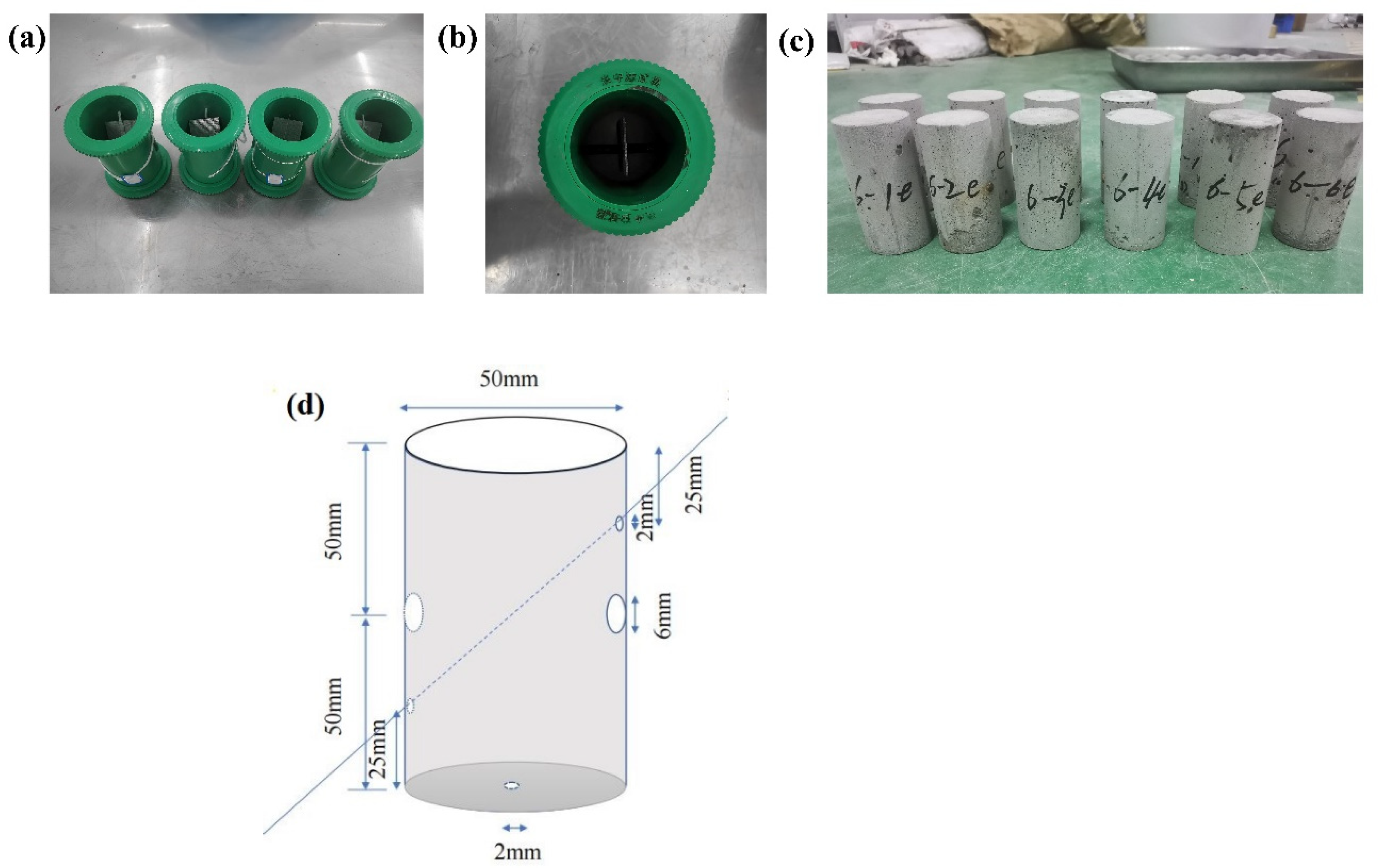
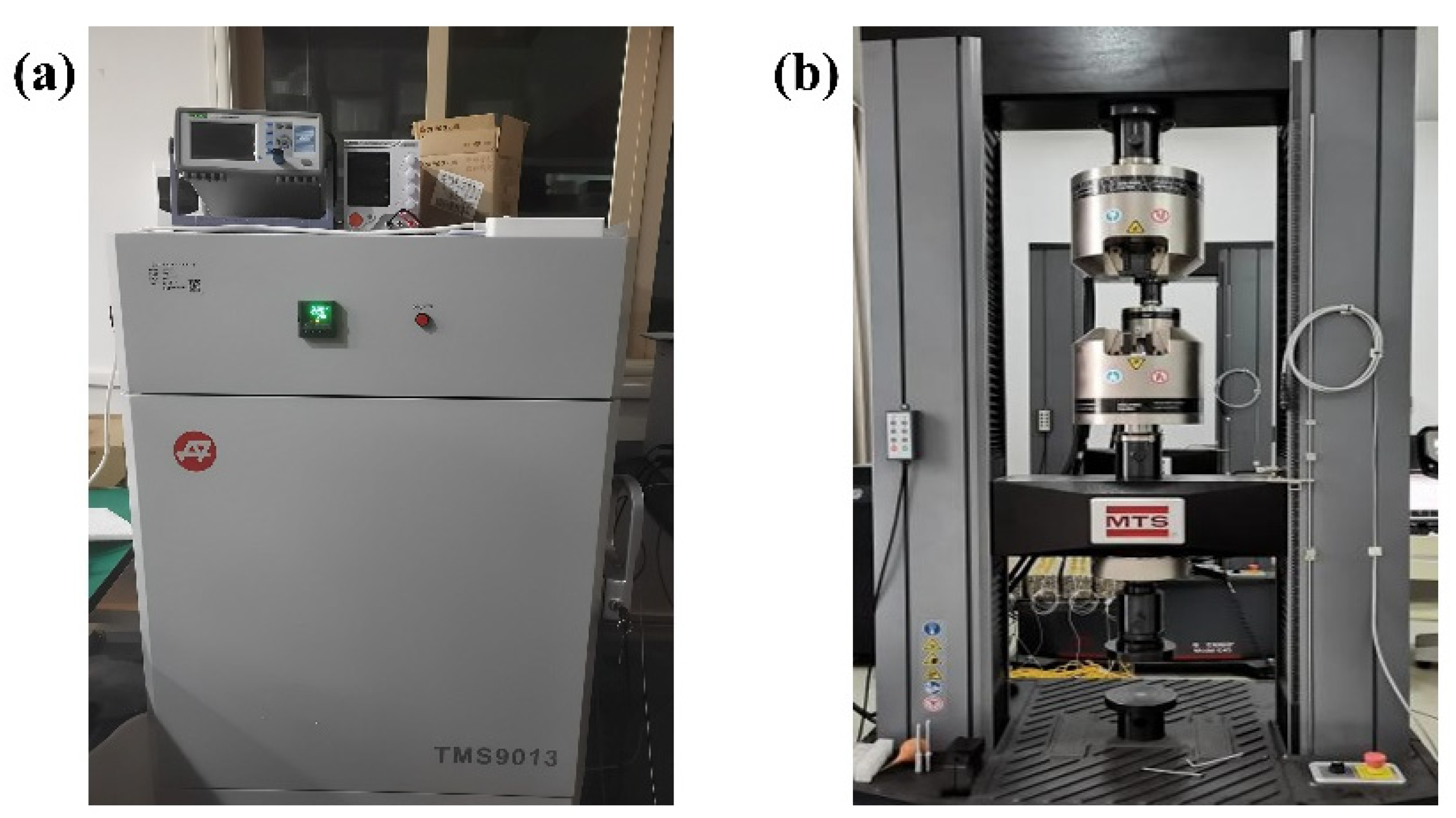
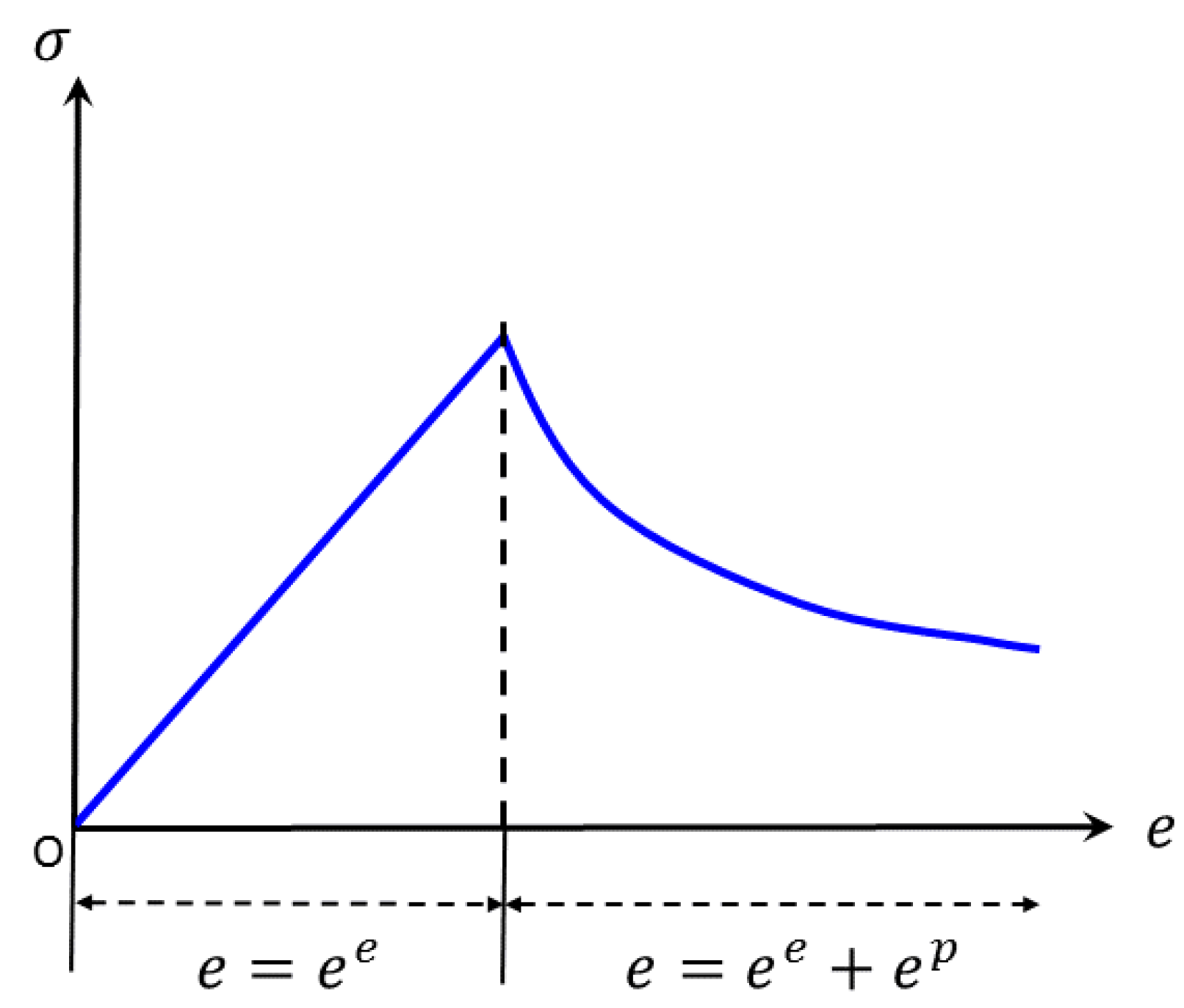

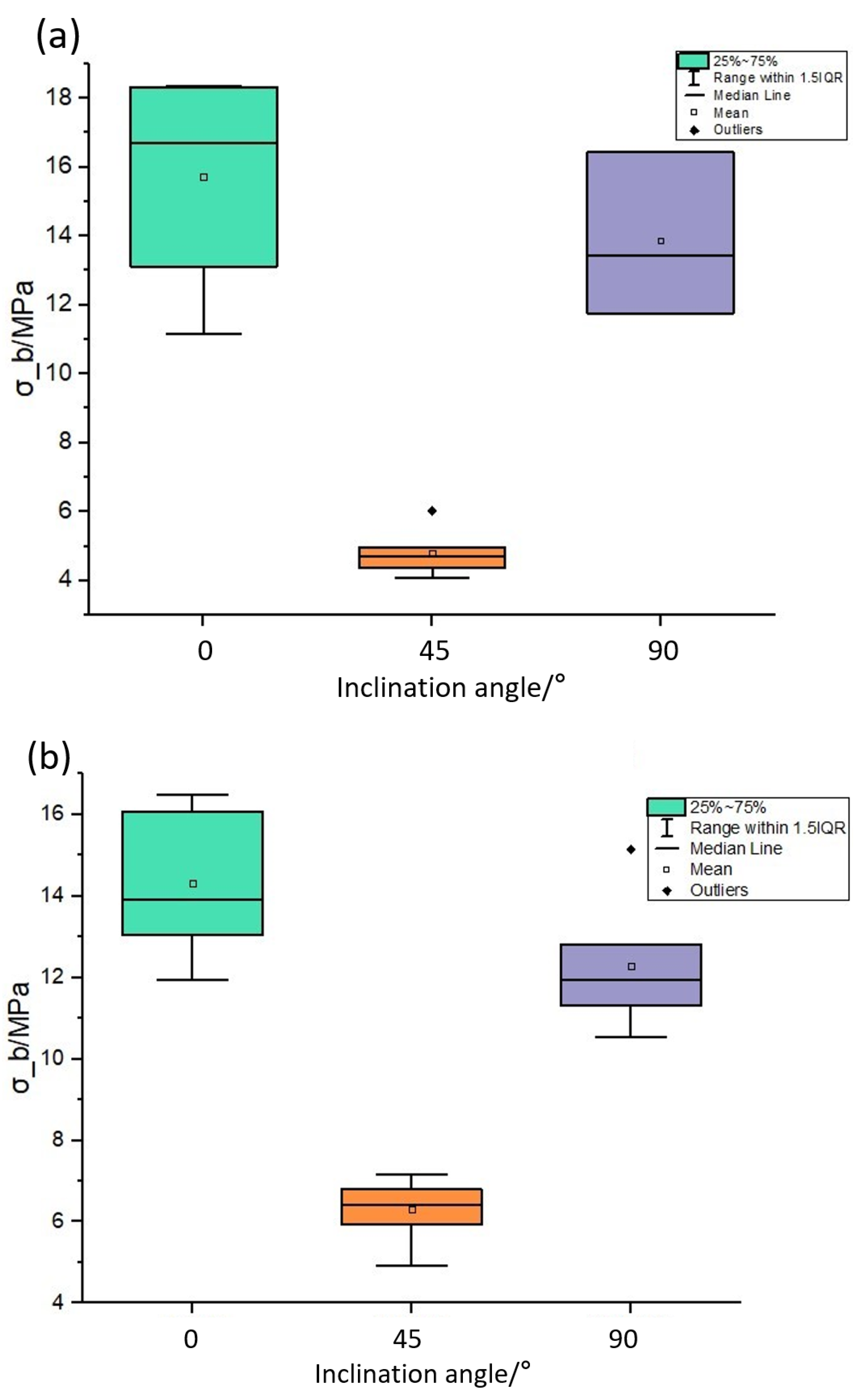
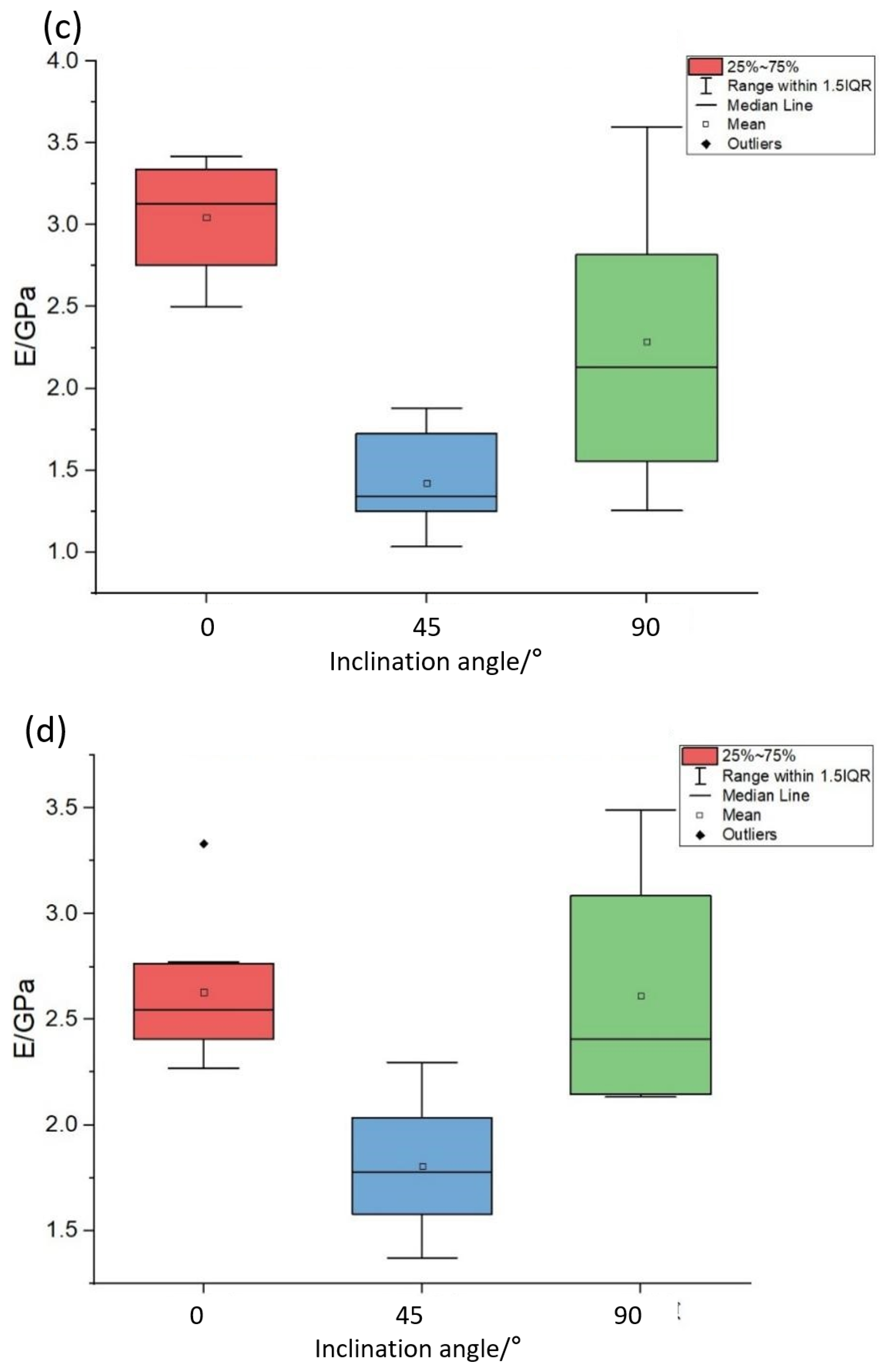


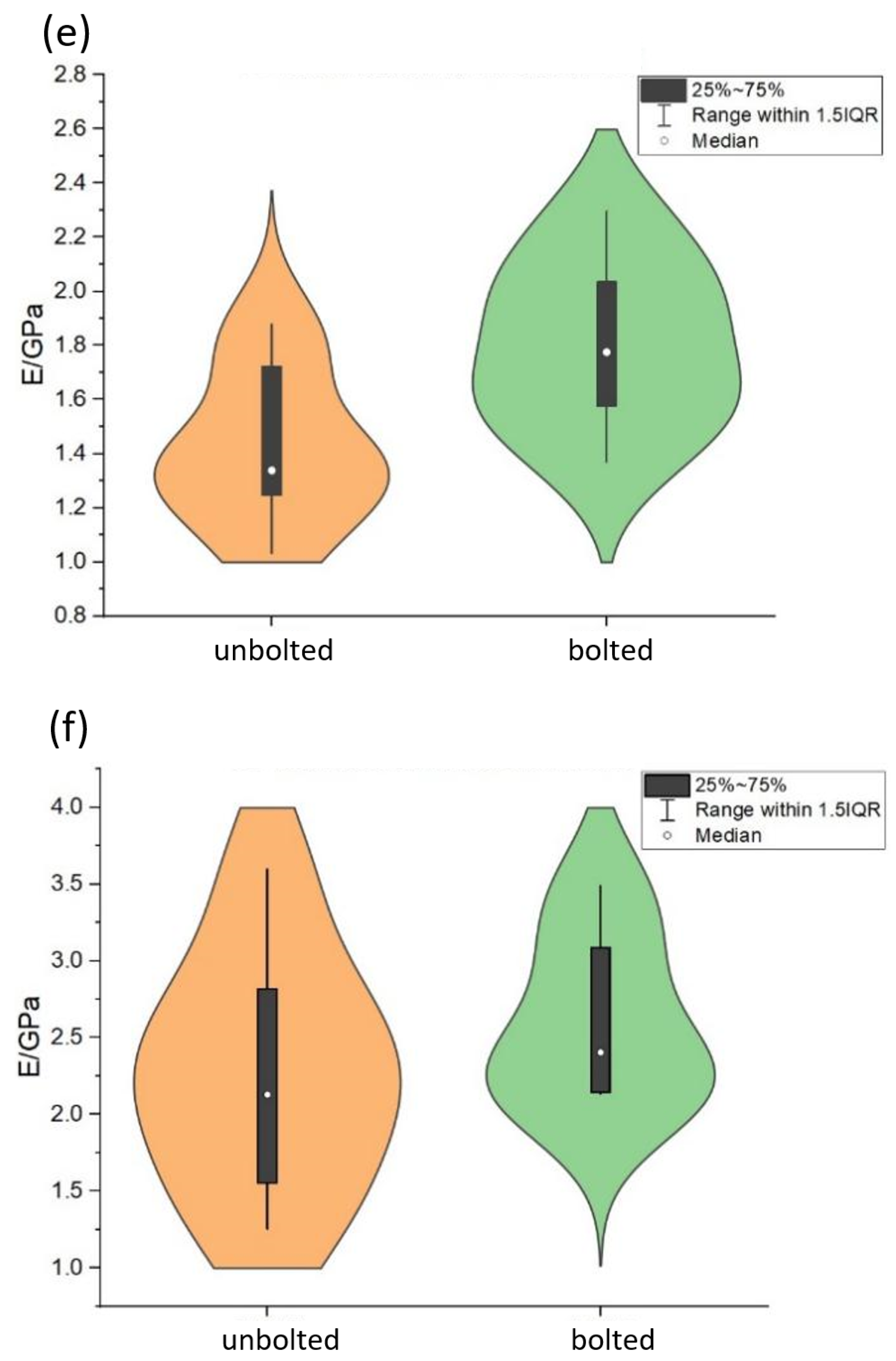
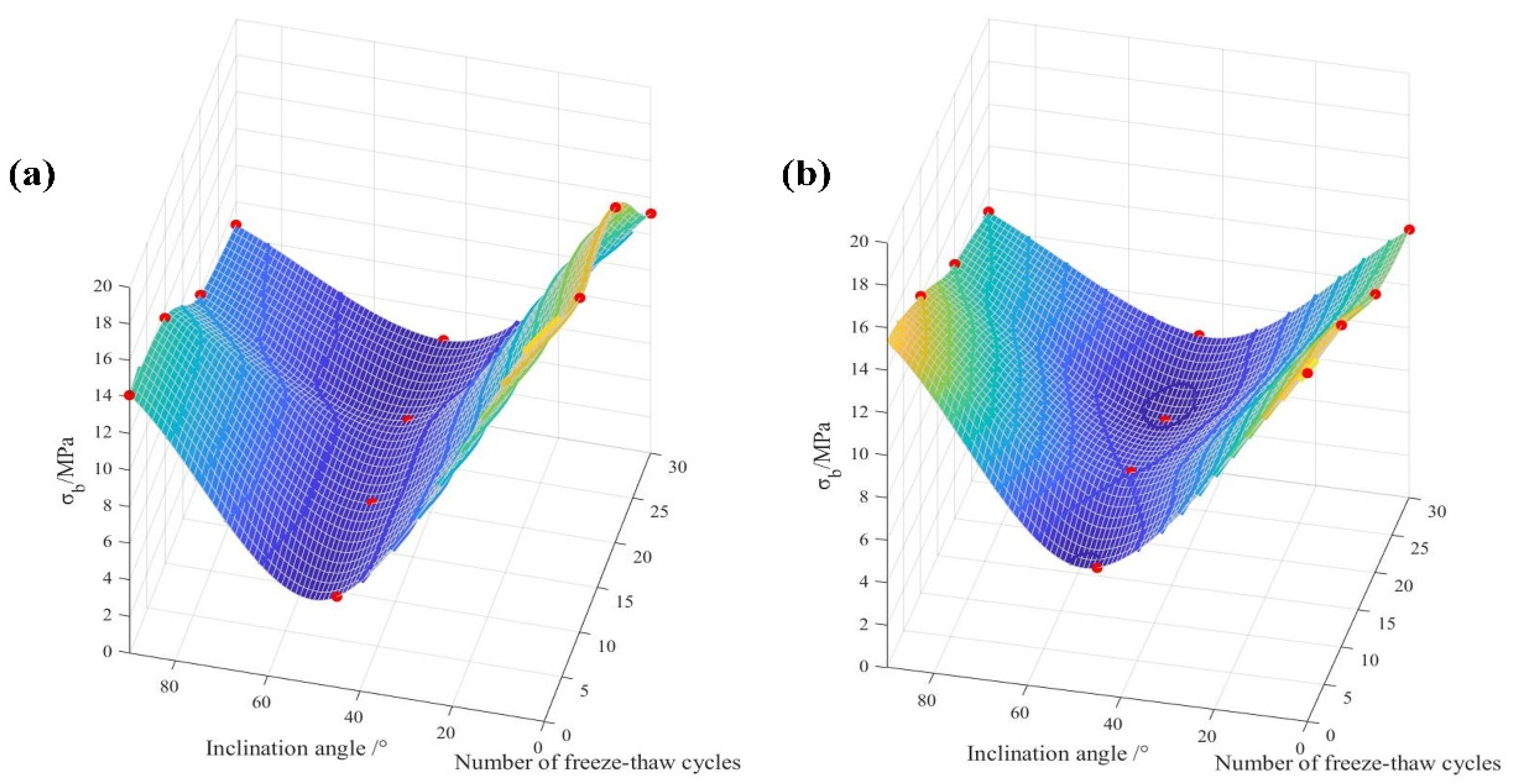


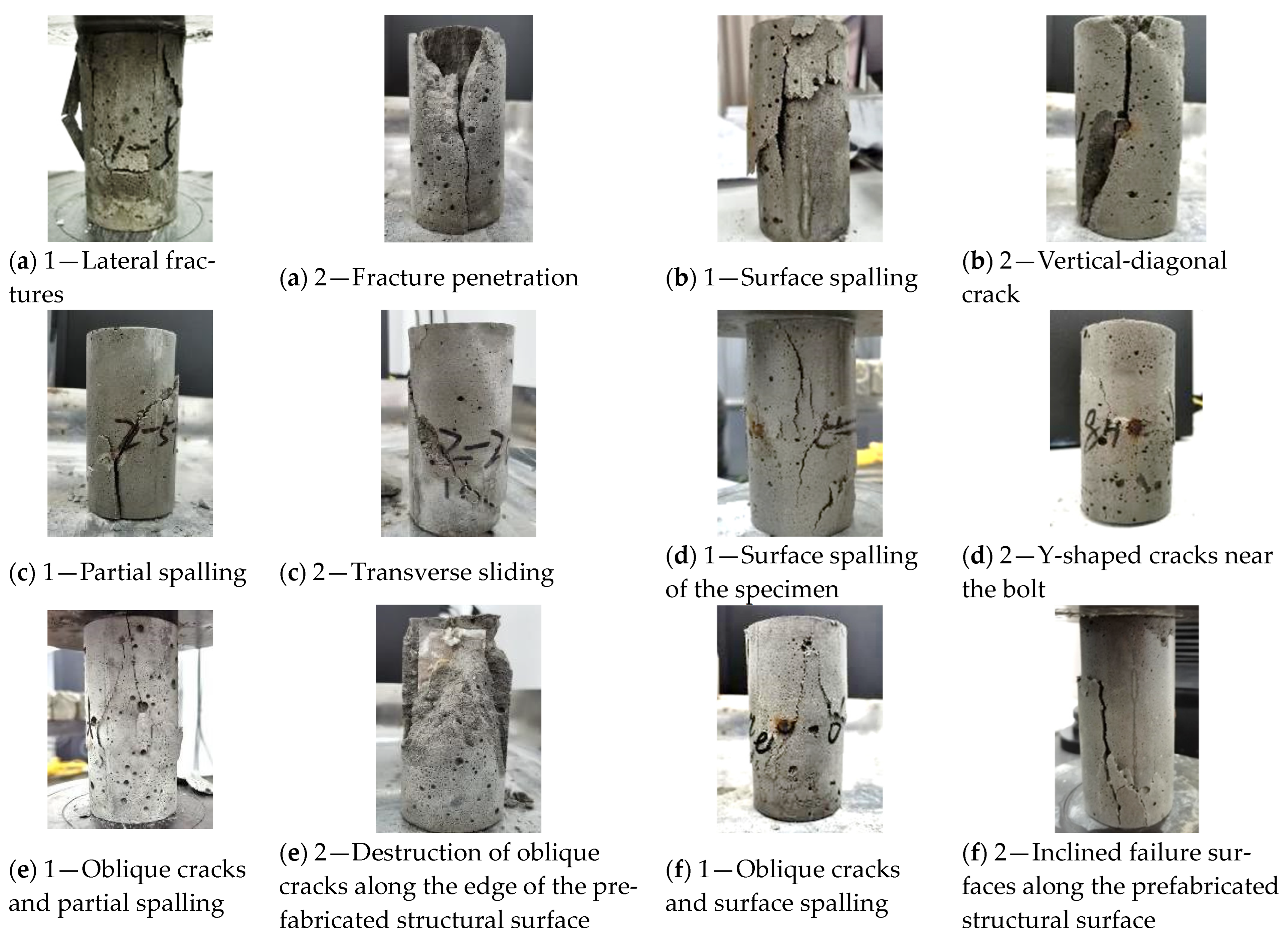
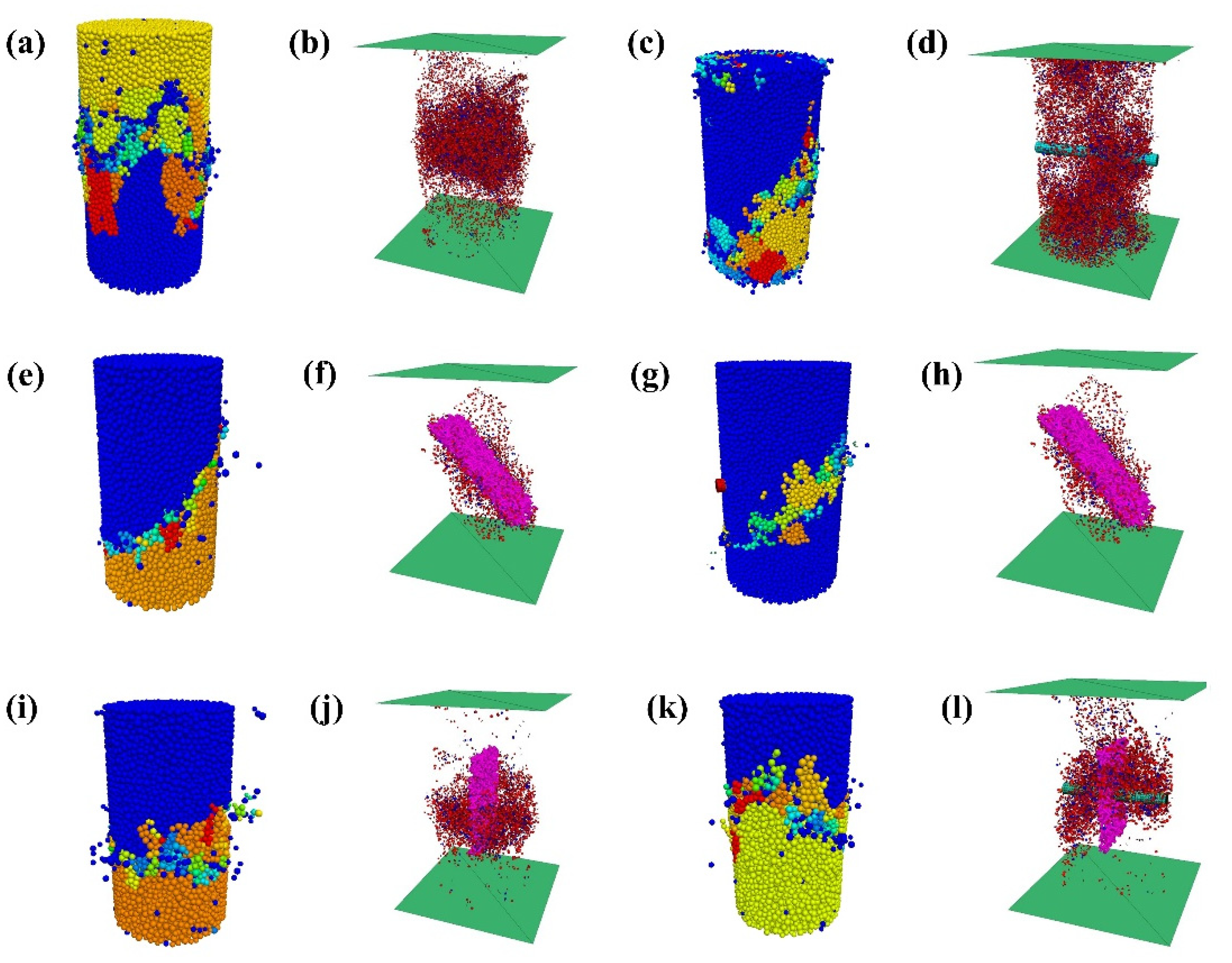
| Inclination Angle of Fracture (°) | With or Without Rock Bolt | Number of Freeze–Thaw Cycles |
|---|---|---|
| None | No | 0, 10, 20, 30 |
| 45° | 0, 10, 20, 30 | |
| 90° | 0, 10, 20, 30 | |
| None | Yes | 0, 10, 20, 30 |
| 45° | 0, 10, 20, 30 | |
| 90° | 0, 10, 20, 30 |
| Particle Parameters | Value | Bonding Parameters | Value |
|---|---|---|---|
| Minimum particle radius (mm) | 0.8 | Parallel cohesive modulus of elasticity/GPa | 4 |
| Maximum particle radius (mm) | 1.28 | Normal-to-shear stiffness ratio | 1.5 |
| Particle density (kg/m)3 | 2700 | Internal friction angle/° | 35 |
| Normal/tangential critical damping | 0.2 | Tensile strength/MPa | 13 |
| Max. bonding distance (mm) | 0.08 | Cohesive force/MPa | 15.6 |
| Linear modulus of elasticity/GPa | 2 | ||
| Linear coefficient of friction | 0.5 |
| Geometrical Parameters | Value | Bonding Parameters | Value |
|---|---|---|---|
| Thickness of contact area (mm) | 5.5 | Normal stiffness | 0.4 |
| Length of structural surface (mm) | 50 | Tangential stiffness | 0.4 |
| Width of structural surface (mm) | 30 | Friction coefficient | 0.1 |
| Undulation angle/° | 0 | Tensile strength/MPa | 0 |
| Cohesive force/MPa | 0 |
| Particle Parameters | Value | Bonding Parameters | Value |
|---|---|---|---|
| Minimum particle radius (mm) | 0.8 | Parallel cohesive modulus of elasticity/GPa | 1.2 |
| Maximum particle radius (mm) | 1.28 | Normal-to-shear stiffness ratio | 1.5 |
| Particle density (kg/m)3 | 2700 | Internal friction angle/° | 30 |
| Normal/tangential critical damping | 0.2 | Tensile strength/MPa | 8 |
| Max. bonding distance (mm) | 0.08 | Cohesive force/MPa | 9.6 |
| Linear modulus of elasticity/GPa | 0.8 | ||
| Linear coefficient of friction | 0.5 |
| Parameter | Density (kg/m3) | Young’s Modulus (MPa) | Poisson’s Ratio | Yield Strength (MPa) | Elastoplastic Tangent Modulus (GPa) |
|---|---|---|---|---|---|
| Value | 7900 | 200 | 0.25 | 450 | 80 |
| σb(45°)/σb(intact) | σb(90°)/σb(intact) | E(45°)/E(intact) | E(90°)/E(intact) | |
|---|---|---|---|---|
| Freeze–thaw, 10 cycles | 28.36% | 73.36% | 42.32% | 65.26% |
| Freeze–thaw, 20 cycles | 26.24% | 53.36% | 46.84% | 53.85% |
| Freeze–thaw, 30 cycles | 32.91% | 66.60% | 48.44% | 59.14% |
| Average value | 29.17% | 64.44% | 45.87% | 59.42% |
| Unfractured | 45° Fracture | 90° Fracture | |
|---|---|---|---|
| Strength of specimen | −8.9% | 31.2% | 9.3% |
| Tangent modulus of specimen | −13.7% | 26.8% | 14.2% |
| Unbolted specimen with no fracture | −0.259 | 21.77 |
| Bolted specimen with no fracture | −0.134 | 16.33 |
| Unbolted specimen with 90° fracture | −0.197 | 14.46 |
| Bolted specimen with 90° fracture | −0.153 | 15.34 |
Disclaimer/Publisher’s Note: The statements, opinions and data contained in all publications are solely those of the individual author(s) and contributor(s) and not of MDPI and/or the editor(s). MDPI and/or the editor(s) disclaim responsibility for any injury to people or property resulting from any ideas, methods, instructions or products referred to in the content. |
© 2024 by the authors. Licensee MDPI, Basel, Switzerland. This article is an open access article distributed under the terms and conditions of the Creative Commons Attribution (CC BY) license (https://creativecommons.org/licenses/by/4.0/).
Share and Cite
Han, F.; Chen, Y. The Bolt Anchorage Performance of Fractured Rock under a Freeze–Thaw Cycle Load. Appl. Sci. 2024, 14, 4152. https://doi.org/10.3390/app14104152
Han F, Chen Y. The Bolt Anchorage Performance of Fractured Rock under a Freeze–Thaw Cycle Load. Applied Sciences. 2024; 14(10):4152. https://doi.org/10.3390/app14104152
Chicago/Turabian StyleHan, Fengyan, and Yu Chen. 2024. "The Bolt Anchorage Performance of Fractured Rock under a Freeze–Thaw Cycle Load" Applied Sciences 14, no. 10: 4152. https://doi.org/10.3390/app14104152
APA StyleHan, F., & Chen, Y. (2024). The Bolt Anchorage Performance of Fractured Rock under a Freeze–Thaw Cycle Load. Applied Sciences, 14(10), 4152. https://doi.org/10.3390/app14104152






